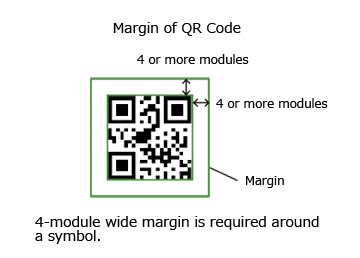Point for determining the code area
Securing Margin

When the symbol version and module size are determined, the size of the QR Code symbol is determined. The QR Code symbol area requires a margin or "quiet zone" around it to be used.
The margin is a clear area around a symbol where nothing is printed. QR Code requires a four-module wide margin at all sides of a symbol.
Example of Calculating QR Code Area
Below is an example of calculating the total QR Code area including margin.
(Example) Creating QR Code to encode 50 alphanumeric characters
- Specify the error correction level as the standard "M".
-
Obtain a version from the Version and maximum data capacity table (find the intersection of alphanumeric characters and Level M).
→ Version 3 capable of storing 50 or more characters. (Version 2 with Level M holds only 38 characters.) -
Use a printer with 400 dpi resolution. → 0.254 mm when printed with 4-dot configuration.
(Equation: 25.4 mm/inch ÷ 400 dpi × 4 dots/module = 0.254 mm/module) - Version 3 = 29 modules, therefore, the size of QR Code is 29 modules × 0.254 mm/module = 7.366 mm.
- Secure a four-module wide margin. 7.366mm + 0.254mm/module × 8 modules = 9.398mm
In other words, the required QR Code area is a square with 9.398mm each side.
If QR Code Area gets Too Large
If the QR Code area obtained in the process above does not fit the printing space, consider the following three points.
- Decrease the symbol version.
- Make the module size smaller.
- Split the QR Code symbol.
